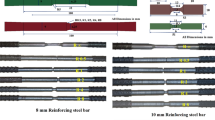Abstract
This paper mainly presents the experimental work on studying the effect of post-tensioned coconut-fibre ropes in controlling uplifts of interlocking blocks in mortar-free concrete construction during seismic loadings. Interlocking blocks are capable of returning back to their original positions after the ground motion because of provided inclined key between the blocks. Coconut fibre reinforced concrete was used to make interlocking blocks. To simulate a single degree-of-freedom system, a mass of 200 kg is attached at the column top. The seismic response of structure is measured in terms of induced accelerations, block uplift, top relative displacement and rope tension. Generally, induced acceleration is increased up to the column mid-height and then decreased a little bit at the column top. The trends of block uplift and rope tension are somewhat similar i.e. non-linear with respect to the applied incremental seismic loadings. Empirical relations, as a function of peak ground acceleration, are also developed from the experimental results to envisage the structure seismic response. There is a percentage difference up to 35% in predicting the structure response which can be attributed towards the complicated nature of the structure versus the simple approach developed. But still, this can help in understanding the behaviour of mortar-free interlocking structure having post-tensioned coconut-fibre rope in a systematic manner.
Similar content being viewed by others
References
Ali, M. (2016). “Use of coconut fibre reinforced concrete and coconutfibre reinforcement in seismic-resistant construction.” Materiales de Construccion, Vol. 66, No. 321, e073, DOI: 10.3989/mc.2016.01015.
Ali, M. (2014). “Seismic performance of coconut-fibre-reinforcedconcrete columns with different reinforcement configurations of coconut-fibre ropes.” Construction and Building Materials, Vol. 70, pp. 226–230, DOI: 10.1016/j.conbuildmat.2014.07.086.
Bommer, J. J., Magenes, G., Hancock, J., and Penazzo, P. (2004). “The influence of strong-motion duration on the seismic response of masonry structures.” Bulletin of Earthquake Engineering, Vol. 2, No. 1, pp. 1–26, DOI: 10.1023/B:BEEE.0000038948.95616.bf.
Clough, R. W. and Huckelbridge, A. A. (1977). In Preliminary experimental study of seismic uplift of a steel frame, Earthquake Engineering Research Center, College of Engineering, University of California.
Elvin, A. and Uzoegbo, H. (2011). “Response of a full-scale dry-stack masonry structure subject to experimentally applied earthquake loading.” Journal of the South African Institution of Civil Engineering, Vol. 53, No. 1, pp. 22–32, http://www.scielo.org.za/pdf/jsaice/v53n1/v53n1a03.pdf.
Harris, W. (2013). 10 Technologies That Help Buildings Resist Earthquakes, 17 September. http://science.howstuffworks.com/innovation/sciencequestions/10-technologies-that-help-buildings-resist-earthquakes.htm.
Housner, G. W. (1963). “The behavior of inverted pendulum structures during earthquakes.” Bulletin of the Seismological Society of America, Vol. 53, No. 2, pp. 403–417, http://authors.library.caltech.edu/47803/1/403.full.pdf.
Huckelbridge, A. A. (1977). Earthquake simulation tests of a nine story steel frame with columns allowed to uplift, Earthquake Engineering Research Center. Berkeley, CA, Report No. UCB/EERC-77-23.
King, S. A., Kiremidjian, A. S., Sarabandi, P., and Pachakis, D. (2005). Correlation of observed building performance with measured ground motion, The John A. Blume Earthquake Engineering Center Rep, 148.
Munawar, S. S., Umemura, K., and Kawai, S. (2007). “Characterization of the morphological, physical, and mechanical properties of seven non-wood plant fibre bundles.” Journal of Wood Science, Vol. 53, No. 2, pp. 108–113, DOI: 10.1007/s10086-006-0836-x.NZS 3112: Part 2. Tests relating to the determination of strength of concrete. 1986.
Priestley, M., Evison, R., and Carr, A. (1978). “Seismic response of structures free to rock on their foundations.” Bulletin of the New Zealand National Society for Earthquake Engineering, Vol. 11, No. 3, pp. 141–150, http://www.nzsee.org.nz/db/Bulletin/Archive/11(3)0141.pdf.
Satyanarayana, K. G., Sukumaran, K., Mukherjee, P. S., Pavithran, C., and Pillai, S. G. K. (1990). “Natural fibre-polymer composites.” Cement and Concrete Composites, Vol. 12, No. 2, pp. 117–136, DOI: 10.1016/0958-9465(90)90049-4.
Spence, R. J. S., Coburn, A. W., Pomonis, A., and Sakai, S. (1992, July). “Correlation of ground motion with building damage: The definition of a new damage-based seismic intensity scale.” In Proceedings of the Tenth World Conference on Earthquake Engineering, Madrid, Spain, Vol. 1, pp. 551–56. http://www.iitk.ac.in/nicee/wcee/article/10_vol1_551.pdf.
Wiebe, L. and Christopoulos, C. (2009). Mitigation of higher mode effects in base-rocking systems by using multiple rocking sections. Journal of Earthquake Engineering, Vol. 13, Vol. Sup1, pp. 83–108, DOI: 10.1080/13632460902813315.
Author information
Authors and Affiliations
Corresponding author
Rights and permissions
About this article
Cite this article
Ali, M. Role of Post-tensioned Coconut-fibre Ropes in Mortar-free Interlocking Concrete Construction During Seismic Loadings. KSCE J Civ Eng 22, 1336–1343 (2018). https://doi.org/10.1007/s12205-017-1609-3
Received:
Revised:
Accepted:
Published:
Issue Date:
DOI: https://doi.org/10.1007/s12205-017-1609-3




